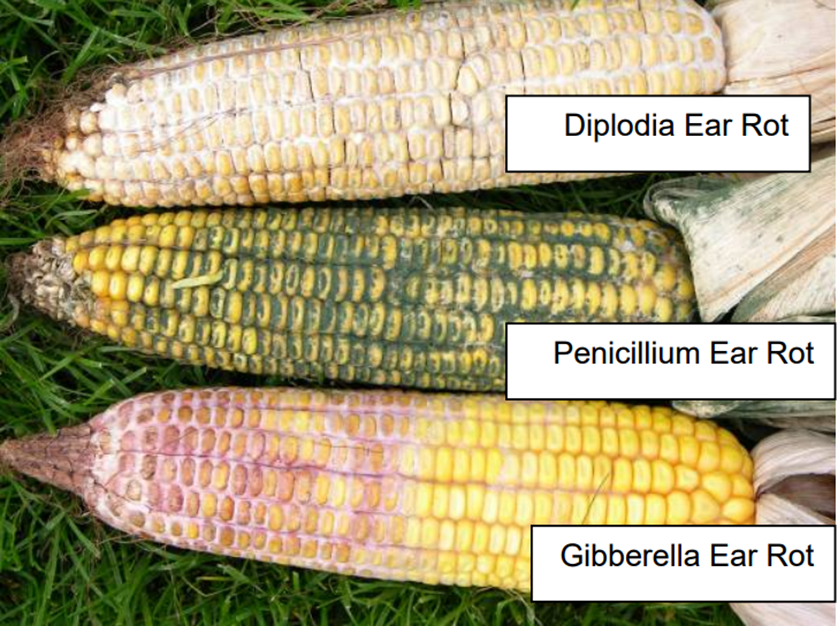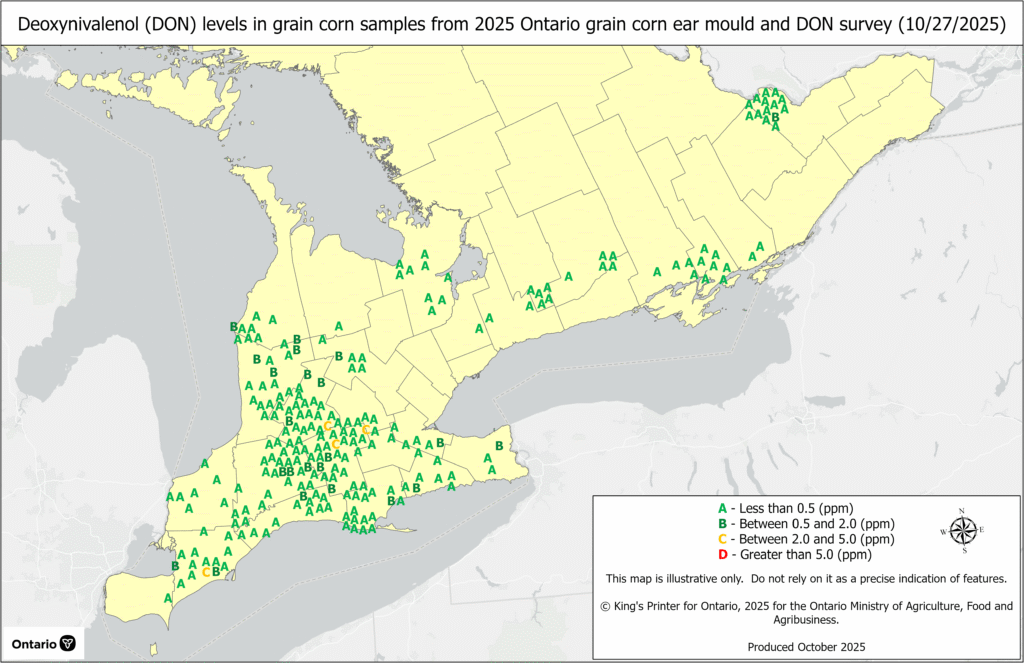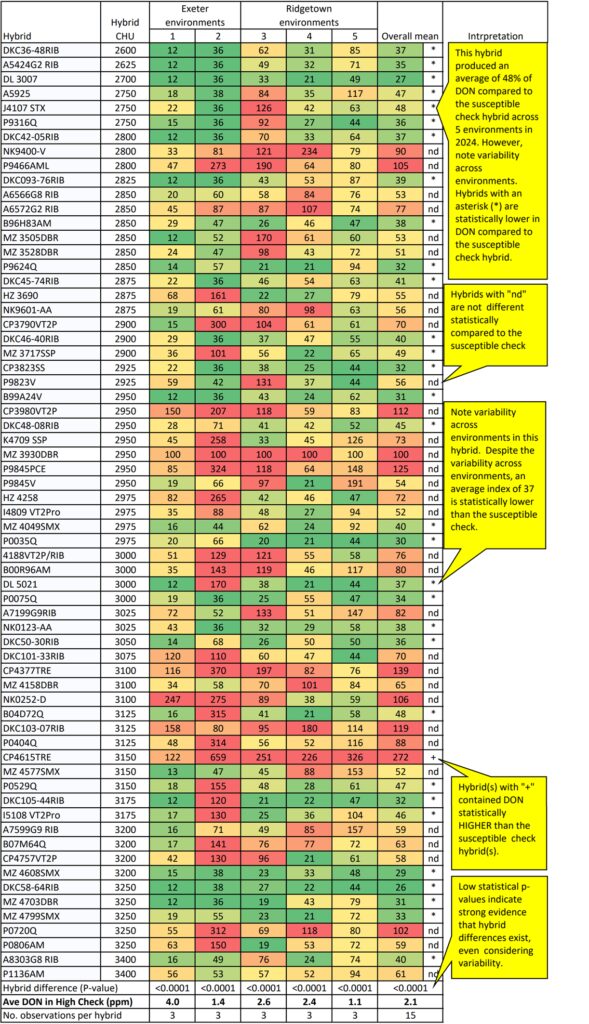OMAFA field crop specialists in collaboration with Grain Farmers of Ontario (GFO) and members of the Ontario Agri-Business Association (OABA) have completed the 2025 annual Ontario corn ear mould and DON mycotoxin survey. Corn ear moulds such as Gibberella and their corresponding mycotoxins occur every year in Ontario. These mycotoxins, particularly deoxynivalenol (DON, also referred to as vomitoxin) are produced primarily by Gibberella/Fusarium ear moulds and can be disruptive when fed to livestock, especially hogs. The 2025 survey found 98% of samples tested low (below 2.00 parts per million (ppm)) for DON, which makes 2025 one of the lowest DON level years in the past 10 years of the DON survey.
Methods
From September 22 to October 3, 2025, 231 ear corn samples were collected from across the province. Five consecutive ears were collected from four random locations (20 ears total) throughout a field and placed into high-temperature driers (80°C) as soon as possible after collection. Pictures were taken to document moulds, insect/bird feeding injury and any other disorders (Figure 1). Dry ears were shelled, ground (coarse) and mixed to ensure sub-sampling consistency. Sub samples were collected and finely ground for DON analysis by quantitative ELISA analysis at the University of Guelph Ridgetown Campus mycotoxin lab of Dr. Gursahib Singh. (ELISA is an enzyme-linked immunoassay laboratory test to detect and measure specific substances).

Figure 1. Some common corn ear moulds which can be observed in Ontario.
Results
Results are presented in Table 1. Visual mould and DON concentrations were lower than normal in the 2025 survey with 98% of samples testing below 2 ppm. This compares to an average of 86% of samples testing below 2 ppm over the past 10 years of the survey (Table 2). While ear moulds were certainly evident in some samples, many displayed no symptoms and only one sample tested 5 ppm and greater.
Table 1. Deoxynivalenol (DON) results from the 2025 Ontario grain corn ear mould and DON survey.
| DON Concentration parts per million (ppm) | Number of Samples* | |
| < 0.50 ppm | 203 | 88% |
| 0.50 to <2.00 ppm | 23 | 10% |
| 2.00 to <5.00 ppm | 4 | 2% |
| 5.00 ppm and greater | 1 | 0% |
| Total | 231 | 100% |
| * percentages may not sum to 100 due to rounding | ||
Table 2. DON results from the past ten years of Ontario grain corn ear mould and DON surveys.
| DON Concentration (ppm) | 2016 | 2017 | 2018 | 2019 | 2020 | 2021 | 2022 | 2023 | 2024 | 2025 |
| < 0.50 | 48% | 69% | 33% | 84% | 58% | 63% | 88% | 41% | 76% | 88% |
| 0.50 to <2.00 | 26% | 17% | 27% | 12% | 31% | 26% | 10% | 36% | 18% | 10% |
| 2.00 to <5.00 | 18% | 8% | 15% | 4% | 10% | 10% | 2% | 18% | 6% | 2% |
| 5.00 and greater | 8% | 6% | 25% | 0% | 0% | 1% | 1% | 5% | 0% | 0% |

Figure 2. Corn ear mould and deoxynivalenol (DON) survey sampling locations and results in 2025.
Distribution of samples and their corresponding DON levels are presented in Figure 2. Even with 98% of 2025 samples testing below 2 ppm, growers should still be vigilant, as they may have individual fields with elevated DON. Fields should be evaluated for risk and consider harvesting and drying higher risk fields to reduce mould growth and subsequent mycotoxin accumulation. Refer to the “Going Forward” section below for management and storage options for corn with higher DON concentrations. Ear moulds and mycotoxins occur every year in Ontario, and fields need to be assessed individually.
Growing Season
Early planting and generally favourable weather dominated the spring of 2025 for many (but not all) parts of the province. Corn planting started in earnest on lighter soils the week of April 20, while planting was in full swing for many others the following week (April 27). Planting was moderated by unsettled weather the first week of May, but progressed quickly afterwards, with many done planting by May 20. Exceptions included heavier textured parts of the province, where planting progress was around a week behind other areas and central Ontario, where persistent rains limited planting for many until the end of May to early June.
With the exception of later-planted corn (areas with frequent rains, heavier-textured soils), a lot of corn had emerged by the week of May 18. The latter half of May turned very cool with well below normal heat unit accumulation. Corn development stalled, and there were concerns over vigour and poor yellow colour in the last couple weeks of May. Heat and sunshine eventually corrected most fields as the weather turned more seasonable by June.
Dry conditions prevailed in many areas through June and early July. Moisture stress became evident in some fields as they approached later vegetative stages in early July. Some tassels were just starting to poke out of the earliest planted fields the week of July 13, while the following week (July 20) and the first half of the next week (July 27) were the peak for pollination across many areas. While there were some scattered rains around this time, the lack of moisture become a concern for many areas.
Dry conditions prevailed for many, and moisture stress symptoms became very evident in some areas (lighter soils, areas not receiving any rainfall) by early August. Dry conditions prevailed for many through grain fill in September. By DON survey timing, despite significant heat in the latter half of September, a significant amount of corn samples appeared to have not yet fully black layered. This may have been related to stressful conditions that challenged grain fill.
Feeding Damage
Ear feeding by pests, particularly western bean cutworm (WBC), corn earworm (CEW) or birds can open husks and damage kernels, which present opportunities for greater ear mould infection and DON. While still only representing a minority of samples, feeding damage was present in some samples. Peak WBC moth flights generally occurred around the first week of August, generally coinciding with the end of tasseling and pollination in many areas. Trap counts submitted to the Great Lakes and Maritimes Pest Monitoring Network were much lower than normal for Ontario in 2025. Where feeding damage was present, visual mould symptoms were usually more apparent.
How to Sample Corn Loads
The importance of collecting representative samples cannot be emphasized enough. Significant variability in mycotoxin testing results can come from poor sampling.
Collecting a Bulk Sample from a Corn Load
While sampling from the top of a storage bin, truck or combine may be convenient, mycotoxins are rarely distributed evenly in grain loads; hence, a sample probe is recommended. The more probes the better, but Ontario research shows that 4 probes sampling the full depth of wagons or trucks can do as good a job representing corn loads as frequent tailgate sampling (swiping stream). Probes are not the major driver of variability experienced with DON testing. For moving grain streams, use a diverter or randomly collect cups of grain. Mix all collected probes/samples into one bulk sample of at least 2 kg.
Collecting an Analysis Subsample from a Bulk Sample
Ontario research shows that one of the most significant sources of variability in DON testing comes from collecting the subsample for DON analysis (e.g. amount of the 2 kg bulk sample that is finely ground for the DON test). Individual kernels can be highly variable in DON and still coarse in size relative to the analysis subsample (e.g. a 200 g whole kernel sample used for fine-grinding may be representing the entire load with only 500 kernels). Therefore, the whole bulk sample should be ground (at least coarsely) and mixed so the analysis subsample contains parts of all kernels in the bulk sample. This subsample can then be ground finer to meet the specifications of the DON test. More details on reducing sample variability through proper sampling and grinding are available HERE. Remember, samples must be processed quickly. It is important to ship or deliver a fresh sample promptly because the longer the sample sits around, the greater the potential for inaccurate results.
Going Forward
This survey does not capture all regions of the province, and results can vary from field to field depending on local weather, hybrid, planting date, insect feeding, rotation, residue levels, fungicide practices and moisture. Results may not capture what is occurring in your field; therefore, monitoring is always recommended.
Timely harvest is important. Leaving infected grain in the field allows ear rot fungi to continue growing, which increases the risk of mouldy grain and mycotoxin contamination. Most ear rot fungi continue to grow (and potentially produce mycotoxins) until grain moisture is below 15%. In high-risk or severely infected fields, growers should consider harvesting at higher moisture and drying below 15%.
If a field contains significant ear moulds (e.g. 10% or more ears with visual mould symptoms), collect a representative sample before harvest and test for mycotoxins before storing or feeding to livestock. A lab test is the only reliable way of determining mycotoxin levels.
If possible, segregate contaminated corn separately.
When ear rots are present, the following harvest, storage and feeding precautions are advisable (adapted from OMAFA Pub 811, Agronomy Guide for Field Crops):
• Harvest and dry as quickly as possible, especially susceptible hybrids. Mould and mycotoxin development cease with grain moisture below 15%.
• If insect or bird damage is confined to certain areas, harvest and handle damaged rows separately.
• Cob, small kernels and fines typically have higher DON concentrations. Adjust harvest equipment to minimize grain damage and to remove insect-damaged, infected or smaller tip kernels. Removing these parts when possible can be beneficial, though large amounts of removal may be required to significantly change grain concentrations.
• Clean bins before storing new grain and cool grain after drying. If possible, segregate corn by DON content to help match end use.
• Check stored grain often for temperature, wet spots, insects and mould. For grain with elevated mould content, market it as soon as possible. Avoid long-term storage.
• Exercise caution when handling or feeding mouldy corn to livestock, especially hog breeding herds and weanling pigs. Pink or reddish moulds are particularly harmful. Test suspect samples for toxins. Work with a nutritionist to manage DON levels in feed.
• Agriculture and Agri-Food Canada guidelines for DON in animal feeds are:
- pigs, calves, lambs, lactating cows, and lactating ewes, 1 part per million (ppm) in the diet
- adult cattle, adult sheep, and poultry, 5 ppm in the diet
Considerations for the 2026 corn crop
Preventing ear rots and mould can be difficult since the weather is critical to development but here are a few things to consider for 2026. Hybrid selection is important, and while tolerant hybrids are available, none have complete resistance. Growers are encouraged to discuss ear mould tolerance with their seed supplier. The Ontario Corn Committee conducts DON hybrid trials to evaluate differences in DON susceptibility across Ontario hybrids (Figure 3). Reports are posted in the Ontario Corn Committee section of gocrops.ca. The 2024 DON hybrid trial report can be found HERE, while the 2025 report should be available in early 2026.

Figure 3. Hybrid table from the 2024 Ontario Corn Committee DON hybrid trial report is available at gocrops.ca.
Crop rotation may help reduce ear rots. While certain foliar fungicides are also registered for suppressing ear rots, they need to be applied at R1 when silks are green. See Ontario Crop Protection Hub HERE for fungicides labelled to suppress ear moulds. Cultural practices such as tillage are shown to have limited success in preventing ear and kernel rots.
Agricorp customers with mould issues are encouraged to immediately contact Agricorp at 1-888-247-4999 and report damage.
Additional Resources
For additional information, see the Crop Protection Network’s “Corn Management Disease Series – Ear Rots” publications at Crop Protection Network
CPN-2001 – Corn – An Overview of Ear-Rots
CPN-2002 – Corn – Mycotoxin FAQs
CPN-2003 – Corn – Grain Sampling and Mycotoxin Testing
CPN-2004 – Corn – Storing Mycotoxin-Affected Grain
Additional articles on managing corn ear moulds and mycotoxins are also available at FieldCropNews.com.
Laboratories Offering Mycotoxin Analysis in Ontario
Good Mycotoxin Test Begins with a “Representative” Sample
Reducing DON Variability in Testing Truckloads of Corn – Prototype Grinder
To Clean or Not to Clean? Managing DON in Grain Corn
Fall Storage Tips for Mouldy Corn
Destroying a Corn Crop at Harvest Time
Land Application of Crops and By-products with Elevated DON Levels
Spring Storage Tips for Mouldy Corn
Acknowledgements
Sincere thanks to those who assisted in co-ordination and collection of samples: Agris Co-operative, Alliance Agri-Turf, Anderson Agronomy Services, Belmont Farm Supply, Benjamins Agronomy Services, Bruch Consulting, Central Ontario FS, Clark Agri Service, Grain Farmers of Ontario, Harriston Agromart, Hoegy’s Farm Supply, Holmes Agro, Maizex Seeds, Midwest Co-op, Millstone Crop Services, Oxford Agropro Ltd., Parrish and Heimbecker, P.T. Sullivan Agro Inc., St. Lawrence Grain and Farm Supply, Sylvite Agri-Services Ltd., Syngenta, TCO Agromart, The Andersons Canada Ltd., Trouw Nutrition, Wellburn Agromart and the many corn growers and OMAFA staff also involved. This co-operation is critical for covering as much of the corn growing areas of the province as possible in a short period of time.
Thanks to Grain Farmers of Ontario, University of Guelph Ridgetown Campus mycotoxin lab and OMAFA for support of the survey as well as Ontario Agri-Business Association (OABA) and its members for their interest and participation.
This project was funded in part by the Sustainable Canadian Agricultural Partnership, a five-year federal-provincial-territorial initiative.